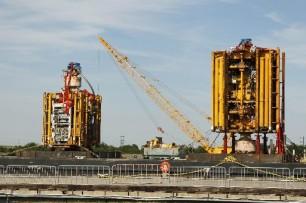http://fuelfix.com/blog/2013/09/30/feds-to-release-new-rules-for-offshore-emergency-equipment-this-year/
Posted on September 30, 2013 at 3:24 pm by Jennifer A. Dlouhy

The blowout preventer stack (right) and lower marine riser stack (left) from the Deepwater Horizon explosion and oil spill (AP file photo/Gerald Herbert)
The nation’s top offshore drilling regulator said he hopes to unveil new requirements for blowout preventers by Dec. 31, nearly four years after the Deepwater Horizon disaster revealed vulnerabilities in the emergency devices.
The hulking devices sit atop wells and can be activated in an emergency to cut drill pipe and block off the hole, trapping oil and gas inside. But a forensic investigation of the blowout preventer used at BP’s failed Macondo well concluded that a powerful rush of oil and gas caused drill pipe to buckle and shift, ultimately preventing powerful shearing rams on the device from cutting the pipe and sealing the hole.
In response, the nation’s three main blowout preventer manufacturers are developing and selling newly robust shearing rams and other designs to slash through thick pipe connections and debris. But a new federal rule would give those voluntary changes the force of law.
The Bureau of Safety and Environmental Enforcement aims to issue those proposed requirements by the end of 2013, said agency director Brian Salerno.
“Blowout preventers are an integral part of the safety systems on drilling rigs,” Salerno said in a letter to Rep. Pete Olson, R-Texas, and other lawmakers. The safety bureau “is working to continue to advance blowout preventer improvements.”
In July, the lawmakers told the safety bureau they were concerned that regulators were “failing to provide clarity for rig operators” while preparing potentially “sweeping new rules” for blowout preventers.
Response ready: Spill containment system headed for Texas coast
Regulators at the safety bureau are likely to lay out specific performance standards for the devices, such as a mandate that they be capable of cutting through casing and drill pipe and effectively sealing a well. Officials could insist that companies use a second set of shearing rams, potentially boosting the odds of successfully cutting drill pipe – a method already being used by some operators in the Gulf of Mexico.
The measure also could require the use of real-time technologies that could aid in diagnosing problems or detecting unexplained surges of oil and gas.
Salerno said his agency is consulting with the manufacturers of blowout preventers and the oil companies that use them as it writes new requirements. The consultation officially began with a public forum in May 2012.
“BSEE has received significant input and specific recommendations from stakeholders, such as industry groups, operators, equipment manufacturers and environmental organizations,” Salerno said.
When a notice of proposed rule making is issued, Salerno said, stakeholders will have a chance to comment further.
Offshore operators say they want to make sure there is a sufficiently long on-ramp for compliance, with plenty of time to redesign blowout preventers and retrofit existing drilling rigs with the devices.
Regulators previously have vowed to give the oil industry plenty of time to adapt, especially given the prospect that requirements could hasten the retirement of some older industry equipment. For instance, a mandate for a second set of shear rams could grow the size of blowout preventers beyond the available space in some rig cellars at shallow-water operations.
The safety bureau is also drafting new standards for oil and gas activity in U.S. Arctic waters, with hopes to unveil that proposal by the end of the year.
(Melissa Phillip / Houston Chronicle)
Employees at National Oilwell Varco work on a lower blowout preventer stack (left) and lower marine riser package (right).
Jennifer A. Dlouhy
Jennifer A. Dlouhy covers energy policy, politics and other issues for The Houston Chronicle and other Hearst Newspapers from Washington, D.C. Previously, she reported on legal affairs for Congressional Quarterly. She also has worked at The Beaumont Enterprise, The San Antonio Express-News and other newspapers. Jennifer enjoys cooking, gardening and hiking. She lives in Washington, D.C., with her husband and toddler son.
Special thanks to Richard Charter